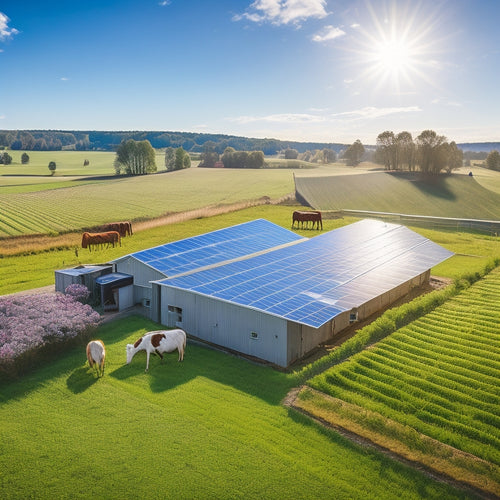
3 Tips for Farm Water Pump Power Systems
Share
When designing your farm water pump power system, you'll want to start by evaluating your farm's water needs, considering factors like crop type, soil moisture, and climate. Next, choose a solar pump that meets your specific requirements, ensuring it's the right type and size for your needs. Finally, prioritize maintenance and performance monitoring to optimize your system's efficiency and minimize downtime, tracking metrics like flow rate, pressure, and power consumption. With a well-designed system, you'll be on your way to reducing waste, lowering your water bills, and enhancing your farm's productivity - and there's more to investigate to get the most out of your system.
Overview
- Ensure accurate water usage monitoring by installing water meters or flow meters to optimize pump performance and reduce waste.
- Select the right solar pump type (centrifugal, submersible, diaphragm, piston, or helical rotor) based on specific farm water needs and flow rate requirements.
- Regularly maintain and inspect pump components to minimize downtime, reduce energy consumption, and enhance overall system performance.
- Verify pump design and installation to ensure efficient and reliable operation, considering factors like pump size, weight, and mounting system.
- Upgrade to energy-efficient components to lower power consumption, reduce water bills, and support sustainable farm growth and productivity.
Assessing Your Farm's Water Needs
About 70% of a farm's water usage goes towards irrigation, making it essential to accurately evaluate your farm's water needs.
You'll want to calculate your water requirements based on factors like crop type, soil moisture, and climate. This will help you determine the ideal irrigation schedule and guarantee irrigation efficiency.
Consider installing water meters or flow meters to monitor your water usage and identify areas for improvement. By enhancing your irrigation system, you can reduce waste, lower your water bill, and increase your farm's overall productivity.
Furthermore, reliable water supply is critical for daily life and economic development, and evaluating your farm's water needs is fundamental to guaranteeing a consistent supply.
Additionally, solar-powered pumps can enhance water quality by providing a dependable supply. Evaluating your farm's water needs is essential to making informed decisions about your irrigation system and achieving long-term sustainability.
Choosing the Right Solar Pump
As you've assessed your farm's water needs, you're now ready to select a solar pump that can efficiently meet those needs. With various solar pump types available, it's crucial to choose the right one for your farm. Consider the flow rate, pressure, and power requirements of your pump. Also, think about installation considerations such as the size of the pump, its weight, and the type of mounting system required.
| Solar Pump Type | Flow Rate (L/min) | Pressure (m) |
|---|---|---|
| Centrifugal | 10-100 | 10-50 |
| Submersible | 5-50 | 20-100 |
| Diaphragm | 1-20 | 5-30 |
| Piston | 0.5-10 | 10-50 |
| Helical Rotor | 0.1-5 | 5-20 |
When selecting a solar pump, verify it's designed for your specific water needs and installation requirements. This will confirm efficient and reliable operation, giving you the freedom to focus on your farm's growth and productivity.
Optimizing Pump Performance
Maximize your solar pump's potential by optimizing its performance. You can do this by ensuring proper pump maintenance, which includes regular cleaning and inspection of the pump and its components. This will help prevent clogs, corrosion, and wear and tear, resulting in improved energy efficiency.
In addition, consider assessing pump efficiency by evaluating flow rate, pressure, and power consumption metrics to identify areas for improvement. Similarly, prioritize easy maintenance features in pump design to reduce downtime and simplify repairs.
You should monitor your pump's performance regularly, checking for signs of wear or damage. By identifying and addressing issues promptly, you can prevent costly repairs and downtime.
Moreover, consider upgrading to energy-efficient components, such as high-efficiency motors or pumps with built-in controllers, to optimize your system's overall performance. By taking these steps, you'll be able to get the most out of your solar pump and enjoy a reliable and efficient water supply for your farm.
Frequently Asked Questions
Can I Use a Wind Turbine to Power My Farm Water Pump?
You can utilize wind energy to power your farm water pump using horizontal or vertical axis wind turbine types, a reliable renewable energy source, but make certain you calculate your energy needs and turbine size correctly for efficient operation.
How Often Should I Inspect and Maintain My Pump System?
You'd have to be a miracle worker to keep your pump running smoothly without a maintenance schedule, but with a rigorous inspection checklist, you'll be checking off tasks like a pro, ensuring your farm's water flows like a never-ending river.
Are Dc-Powered Pumps More Efficient Than Ac-Powered Pumps?
You'll find that DC-powered pumps often offer higher efficiency, converting most of the input power into useful work, whereas AC-powered pumps prioritize reliability, sacrificing some efficiency for ruggedness and simplicity, so consider your farm's specific needs.
Can I Use a Battery Bank to Store Excess Energy?
You can utilize solar energy to charge a battery bank, storing excess energy for later use, and leveraging renewable resources to power your water pump, granting you independence from the grid and reducing your reliance on non-renewable energy sources.
Are Farm Water Pump Power Systems Eligible for Government Incentives?
You'll be pleased to know that, yes, you're eligible for government incentives with farm water pump power systems, which can provide access to various government programs and funding opportunities, helping you save money and achieve energy independence.
Ready to Buy
Fine-tune your farm's fluid flow by focusing on these fundamental aspects: precise pump selection, optimized performance, and pinpointed power systems. By prioritizing these practical parameters, you'll pump up productivity, pare down energy costs, and perfect your precious water resources. With these potent principles in place, your farm's future will flow freely, fueled by a flawless fusion of function and efficiency.
Related Posts
-

What Do I Need to Know About Farm Solar Panels
When considering farm solar panels, you need to assess costs, benefits, and technical specifics. Initial investment c...
-

Diy Off Grid Solar
By embracing DIY off-grid solar, you can break free from grid dependence, slashing your energy bills by up to 90% and...
-

The Future of Residential Energy Storage
The future of residential energy storage looks promising and cost-effective for you. With lithium-ion battery prices ...


